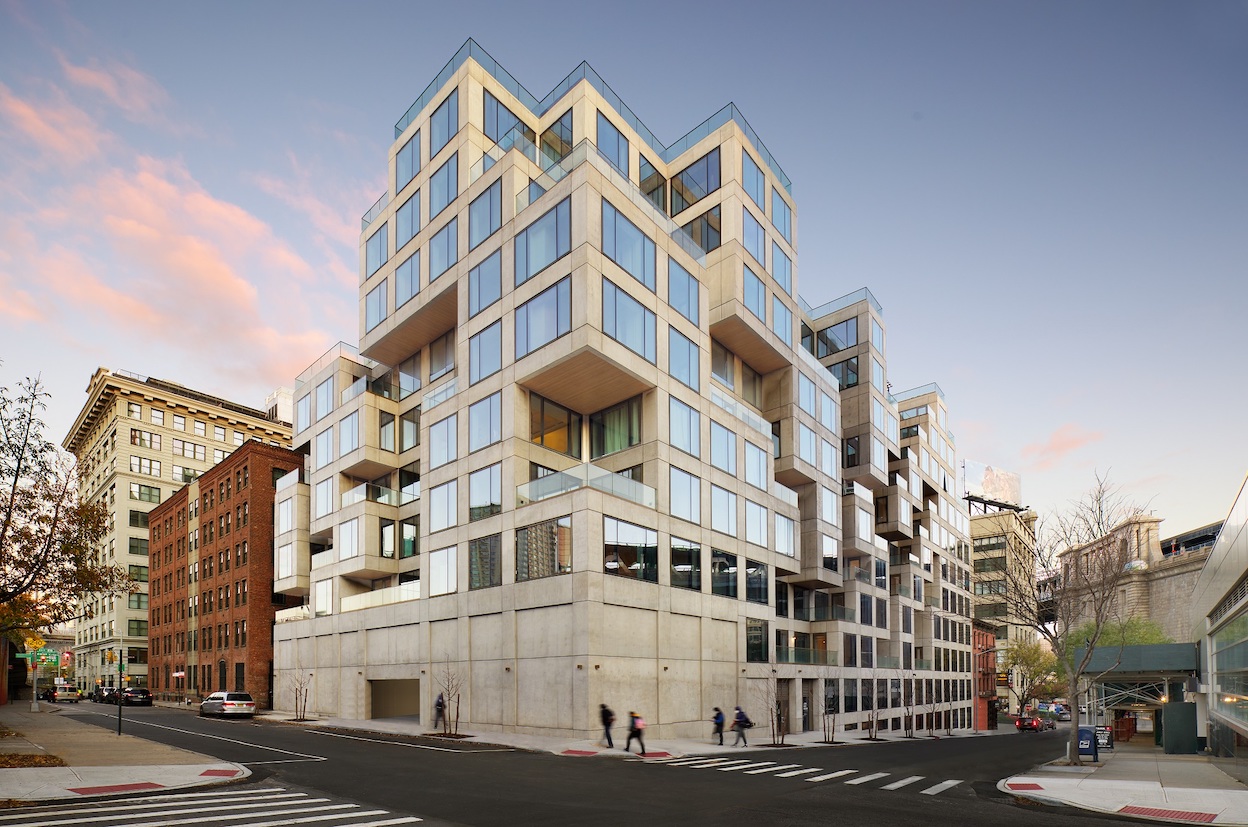


Cantilevered towers help deal with space limitations in New York City. They start narrow at the street but expand as they rise, more lollipop than traditional wedding cake.
Ask a child to draw a picture of a skyscraper and they’ll probably sketch a familiar form: perhaps a skinny rectangle standing on its end, or a tapered block that culminates in a pointed spire. After all, for more than a century, that’s typically how tall buildings have been designed.
But in New York, where land is scarce and the streetscape is increasingly crowded, a growing number of residential projects are turning the conventional skyscraper on its head. By building with cantilevers, they start narrow at the street but expand as they rise, more lollipop than traditional wedding cake.
Despite the structural challenges inherent in making large parts of buildings seemingly hover in midair, there are many potential advantages to doing so, depending on the limitations of a building site. Sometimes, pushing more of a building’s allowable square footage up to higher floors by adding cantilevers is a way to create more apartments with better views and light.
Other times, when developers are limited by a height restriction, building sideways over a neighbor is the only way to maximize square footage as part of an air rights deal. In still other cases, it’s about sidestepping competing towers, creating more appealing space at ground level or simply realizing a design statement that can help a new project stand out from the crowd.
“Cantilevers offer a nice element of drama to the form of a building,” said Michael Kirchmann, an architect who is the founder and chief executive of the development company GDSNY, which recently completed the Emerson, an eight-unit condominium at 500 West 25th Street where the top floors cantilever toward the High Line. “A cantilever just adds to that dynamism and excitement people have in unraveling in their heads how a building stands up.”
While cantilevers might be thrilling to look at, they also offer real rewards for residents and developers in many cases. “Generally speaking, the further you get up into the building, the more valuable the space becomes,” Mr. Kirchmann said. “So, it’s not only an architectural thing, but it can become financially very beneficial for a project as well.”
The cantilevered top of the Emerson doesn’t hang over a neighboring building — the 10-story building rises completely within its own zoning envelope. GDSNY created the cantilever by holding the western side of the building back from its neighbor, Mr. Kirchmann said, which provided a number of advantages. The space in between the two buildings allowed the firm to create a private outdoor terrace for every unit and add windows where there otherwise would have been solid wall along the lot line. The top floors, meanwhile, are boosted up higher than they would be without the cantilever, providing views of the High Line and Hudson River.
At 98 Front Street in Dumbo, Brooklyn, the architecture firm ODA designed a condo for Hope Street Capital with a multitude of cantilevers to provide more outdoor terraces and windows for more apartments. The building resembles an uneven composition of stacked cubes, where some boxes hang off others.
“The old way of building in cities is simply an extrusion of a floor plate, endlessly or until zoning stops us,” said Eran Chen, the founding principal of ODA. “It might be efficient and easy to construct, but ultimately is very limiting in terms of the most essential elements that I believe we’re looking for in our community and built environment.” Those elements include access to natural light and air, as well as opportunities for casual encounters with our neighbors, Mr. Chen said, who imagines residents at 98 Front might greet each other from their terraces.
Breaking from a building that goes straight up resulted in some challenges, said Sha Dinour, a partner at Hope Street Capital and the president of Triumph Property Group. “It’s certainly more complicated to build,” he said, noting that ODA’s design resulted in nearly a hundred different layouts for the building’s 165 apartments, and that plumbing, electrical, waterproofing and insulation all needed to track the building’s shifting shape.
With so many different layouts, “the selling process was difficult,” he added, because apartment hunters had so many units to choose from (the building is more than 60 percent sold). The upside for buyers, however, is that “people tend to really have unique, one-of-a-kind homes that don’t repeat themselves.”
The size of buildings in New York is controlled, in part, by something called the floor area ratio — the amount of total buildable floor area allowed per square foot of the building lot. When developers want to build bigger than their lot size allows, one option is to purchase air rights, also known as development rights, from an underdeveloped neighboring lot.
In many cases, that extra floor area is simply stacked on top of a proposed development, resulting in a taller tower. But some zoning districts place height limits on buildings, which can create situations where the only way to use all of the air rights available from a neighbor is to build sideways in the sky instead of up.
“When I typically would see a cantilever is when I’m in a zone that has a height limit,” said Daniel H. Braff, a zoning and land use attorney at Sahn Ward.
“I can’t utilize all of your floor area within my building envelope,” he explained, imagining a developer’s perspective. “I want to buy all this floor area and build a larger building, but I can’t go up. I’m capped. So the only way to utilize your floor area in my new building is to cantilever over your building.”
That wrangling around zoning envelopes can lead to some dramatic looking structures. At 251 West 91st Street, for instance, ODA has designed a 20-story gravity-defying tower named Era, a new condo project from Adam America Real Estate and Northlink Capital that is currently under construction.
Only 50 feet wide at the ground where it faces Broadway, the limestone-clad building expands north in the sky in a series of cantilevers over a SoulCycle and Equinox gym, stretching out an additional 45 feet by the top, nearly doubling its width beneath a height limit of 210 feet.
“It’s really a piece of art or a statue that is going to reveal itself in the months to come,” said Tomer Yogev, the head of development at Adam America Real Estate. All that horizontal space on the roof provided extra space for shared amenities, Mr. Yogev said, including an outdoor pool.